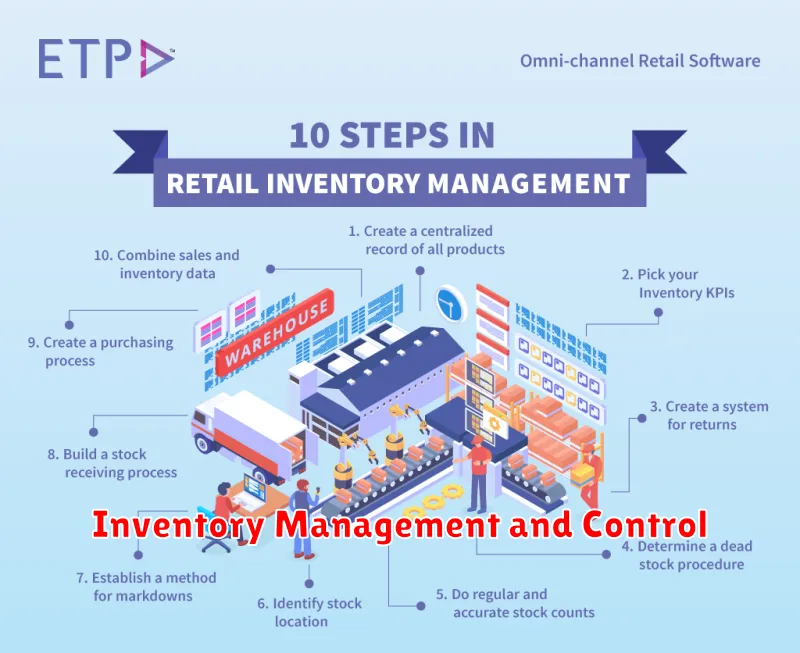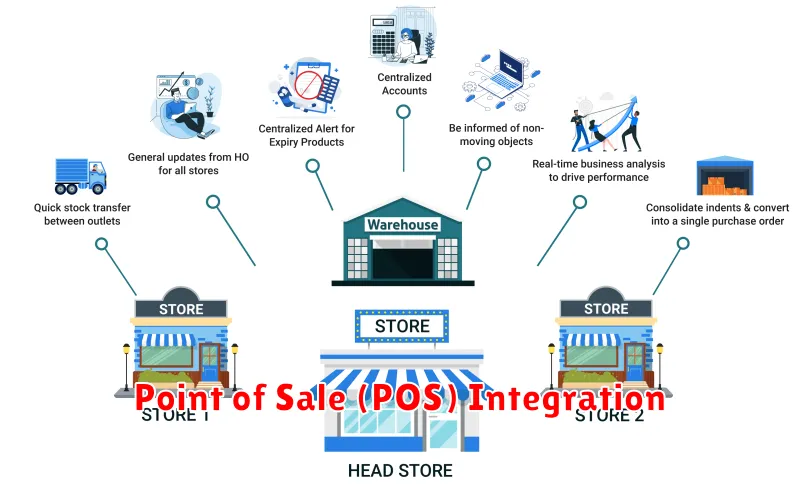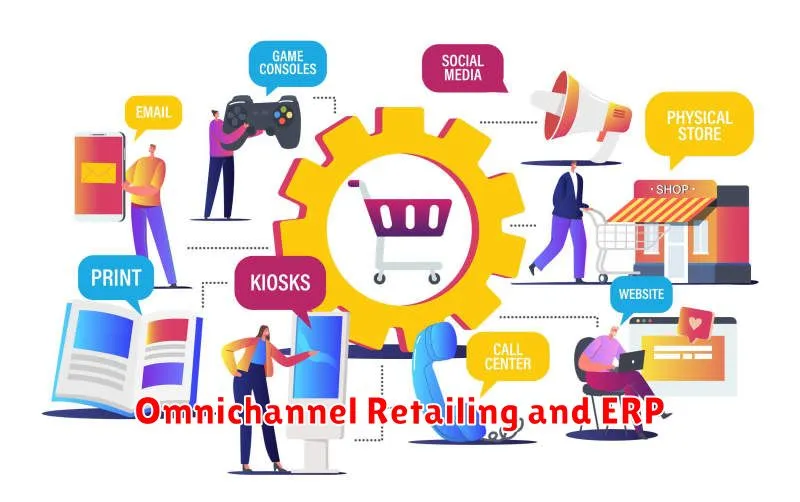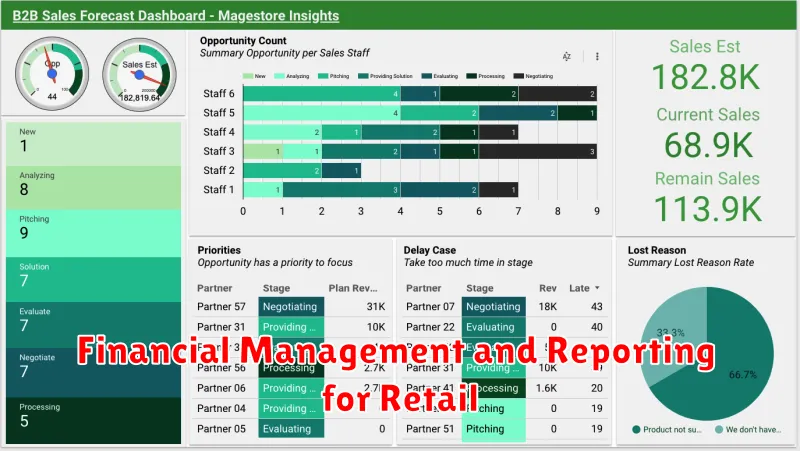Are you a retail business owner looking to streamline your operations, improve efficiency, and boost profits? If so, implementing an ERP solution may be the answer you’ve been searching for. ERP systems, or Enterprise Resource Planning systems, provide a comprehensive platform that integrates all aspects of your business, from inventory management and sales to customer relationship management and financial reporting. This article will delve into the benefits of ERP solutions for retail businesses, exploring key features and functionalities, as well as factors to consider when choosing the right system for your needs.
Unique Requirements of the Retail Industry
The retail industry is a dynamic and complex environment with its own unique set of requirements. It is constantly evolving, requiring businesses to adapt to new technologies, changing consumer preferences, and fierce competition. From managing inventory and optimizing store layouts to engaging customers and providing exceptional service, the demands are high. This article will delve into the unique requirements of the retail industry, highlighting the critical factors that contribute to success.
Customer-Centric Approach
At the heart of the retail industry lies the customer. The industry thrives on providing a positive customer experience and meeting their needs. This requires a strong focus on customer service, which is often the differentiator between successful and failing businesses. Retailers must prioritize customer satisfaction and build strong relationships to foster loyalty and repeat business. From providing personalized recommendations to offering convenient payment options, exceeding customer expectations is paramount.
Effective Inventory Management
Efficient inventory management is crucial for any retailer, as it directly impacts profitability and customer satisfaction. Keeping the right products in stock at the right time is a delicate balance, requiring accurate forecasting, real-time inventory tracking, and efficient ordering processes. Retailers must optimize their supply chains to ensure timely delivery and minimize stockouts, while avoiding excessive inventory that leads to storage costs and potential obsolescence.
Strategic Store Design and Layout
The physical store environment plays a significant role in attracting and engaging customers. Retailers must carefully consider the store’s design and layout to create a welcoming and inviting atmosphere. This involves creating a clear and easy-to-navigate shopping experience, maximizing space utilization, and showcasing products effectively. Strategic placement of merchandise, appropriate lighting, and engaging visual displays are essential for driving sales and improving customer satisfaction.
Adapting to Technological Advancements
The retail industry is constantly evolving with new technologies emerging that redefine customer expectations. Retailers must embrace these advancements to stay ahead of the curve and provide a seamless and convenient shopping experience. This includes leveraging e-commerce platforms, implementing mobile payment options, adopting data analytics for personalized marketing, and incorporating omnichannel strategies that integrate online and offline experiences.
Strong Marketing and Branding
In today’s competitive landscape, it is vital for retailers to establish a strong brand identity and effectively communicate their value proposition to target customers. This requires a comprehensive marketing strategy that leverages various channels, including digital advertising, social media marketing, email campaigns, and public relations. Effective branding helps retailers stand out from the competition, build customer loyalty, and drive sales growth.
In conclusion, the retail industry presents a unique set of challenges and opportunities. By prioritizing customer satisfaction, implementing efficient inventory management systems, optimizing store design, embracing technological advancements, and building a strong brand, retailers can navigate the complexities of the market and achieve long-term success.
Inventory Management and Control

Inventory management and control are crucial aspects of any business, regardless of size or industry. It involves planning, organizing, and controlling the flow of goods, from the point of origin to the point of consumption. Effective inventory management ensures that the right products are available at the right time, in the right quantity, and at the right cost. This minimizes stockouts, reduces waste, and optimizes profitability.
The goal of inventory management is to strike a balance between demand and supply. Maintaining an adequate inventory level is essential to meet customer demands and avoid lost sales. However, excessive inventory can lead to storage costs, obsolescence, and shrinkage. Efficient inventory control involves minimizing holding costs while ensuring timely fulfillment of orders.
Several techniques are used for inventory management, including:
- Just-in-time (JIT) inventory: This method aims to receive materials and produce goods only when needed. It minimizes inventory holding costs but requires a high degree of coordination and reliable suppliers.
- Materials Requirements Planning (MRP): This system uses computer software to plan and manage inventory levels based on production schedules and demand forecasts.
- ABC analysis: This method categorizes inventory items based on their value. A-items are high-value items that require close monitoring, while C-items are low-value items that can be managed less rigorously.
- Economic Order Quantity (EOQ): This formula calculates the optimal order quantity to minimize total inventory costs.
Implementing a robust inventory management system offers numerous benefits:
- Improved customer satisfaction by meeting demand and reducing lead times.
- Reduced costs through minimized waste, storage expenses, and obsolescence.
- Enhanced cash flow by optimizing inventory levels and reducing holding costs.
- Increased efficiency by streamlining processes and improving supply chain visibility.
In conclusion, inventory management and control are essential for business success. By implementing effective strategies and utilizing appropriate tools, businesses can optimize inventory levels, minimize costs, and improve overall profitability. This leads to enhanced customer satisfaction and a competitive advantage in the market.
Point of Sale (POS) Integration

Point of sale (POS) integration is the process of connecting your POS system to other business applications, such as your inventory management system, accounting software, or customer relationship management (CRM) system. This integration can automate many tasks, improve accuracy, and provide valuable insights into your business operations.
Here are some of the key benefits of POS integration:
- Improved accuracy: POS integration can help reduce errors by automating data entry and eliminating the need for manual data transfer.
- Increased efficiency: By streamlining workflows, POS integration can save you time and effort. For example, you can automatically update inventory levels when a sale is made, or generate invoices directly from your POS system.
- Better decision-making: With access to real-time data from your POS system, you can make more informed decisions about your business. For example, you can track sales trends, identify popular products, and analyze customer behavior.
- Enhanced customer experience: POS integration can help you provide a better customer experience by enabling faster checkout times, personalized recommendations, and loyalty programs.
There are a number of different ways to integrate your POS system. Some POS systems offer native integrations with other applications, while others require the use of third-party connectors. The best integration method for your business will depend on your specific needs and requirements.
If you’re considering POS integration, it’s important to choose a solution that is compatible with your existing systems and meets the needs of your business. You should also consider the cost of integration, as well as the time and effort required to implement it.
Customer Relationship Management (CRM) for Retail
In the competitive landscape of the retail industry, building and maintaining strong customer relationships is paramount to success. This is where Customer Relationship Management (CRM) comes into play. CRM is a comprehensive strategy and technology solution designed to manage and enhance customer interactions throughout the entire customer lifecycle.
For retailers, CRM is not just about collecting data; it’s about leveraging that data to create personalized experiences, foster loyalty, and drive sales. By understanding customer preferences, purchase history, and engagement patterns, retailers can tailor their marketing campaigns, provide relevant product recommendations, and offer exceptional customer service.
Key Benefits of CRM for Retail:
- Enhanced Customer Understanding: CRM systems centralize customer data, providing retailers with a 360-degree view of each customer. This deep understanding enables them to identify individual needs, preferences, and buying behavior.
- Personalized Marketing & Communication: CRM empowers retailers to personalize marketing messages, promotions, and communication channels to align with individual customer profiles. Targeted campaigns increase engagement and conversion rates.
- Improved Customer Service: By providing customer service agents with access to customer history and preferences, CRM streamlines interactions, resolves issues faster, and enhances customer satisfaction.
- Increased Sales & Revenue: Personalized experiences, targeted marketing, and exceptional customer service all contribute to increased sales, customer lifetime value, and overall revenue growth.
- Customer Loyalty & Retention: CRM systems foster customer loyalty by nurturing relationships, providing value-added services, and rewarding repeat business.
Implementing CRM in Retail:
Retailers can effectively implement CRM by following these steps:
- Define Business Goals: Clearly outline what you aim to achieve with CRM, such as increased customer retention, higher sales, or improved service quality.
- Choose the Right CRM Solution: Select a CRM system that aligns with your specific business needs, budget, and technical capabilities.
- Data Integration & Cleanse: Integrate existing customer data into the CRM system and ensure data accuracy and consistency.
- Define Customer Segments: Group customers into meaningful segments based on demographics, purchase history, or other relevant factors. This enables targeted marketing efforts.
- Develop Personalized Strategies: Create individualized strategies for each customer segment, focusing on tailored communications, product recommendations, and customer service approaches.
- Monitor & Optimize: Track key metrics, analyze results, and continually optimize your CRM strategy for better performance.
Conclusion:
In today’s customer-centric retail environment, CRM is no longer optional; it’s a necessity for survival. By embracing CRM, retailers can gain a competitive advantage, foster deeper customer relationships, and drive sustainable growth. The power of CRM lies in its ability to transform data into meaningful insights, enabling retailers to deliver personalized experiences that resonate with individual customers.
Omnichannel Retailing and ERP

In today’s dynamic retail landscape, consumers demand seamless experiences across all touchpoints. This necessitates businesses to adopt an omnichannel strategy, providing a unified customer experience across physical stores, websites, mobile apps, and social media platforms. To facilitate this, an effective Enterprise Resource Planning (ERP) system is crucial.
An ERP system acts as the central nervous system of a business, integrating various departments and functions, including inventory management, order fulfillment, customer relationship management (CRM), and financial reporting. For omnichannel retailing, an ERP system plays a vital role in enabling:
Unified Inventory Management
Omnichannel retailing requires accurate and real-time inventory visibility across all channels. An ERP system provides a centralized platform for tracking inventory levels, enabling businesses to fulfill orders efficiently and avoid stockouts. This ensures that customers can purchase products regardless of their preferred shopping channel.
Streamlined Order Fulfillment
With customers expecting fast and accurate order fulfillment, an ERP system automates order processing and tracking, ensuring seamless order management across multiple channels. This includes handling online orders, in-store pickups, and returns, providing a consistent customer experience.
Personalized Customer Experiences
An ERP system can integrate with CRM data, allowing retailers to understand customer preferences and purchase history. This enables personalized recommendations, targeted promotions, and customized customer service, enhancing the overall shopping experience.
Improved Data Analytics
By collecting data across all channels, an ERP system provides valuable insights into customer behavior, sales trends, and inventory performance. This data-driven approach empowers businesses to make informed decisions, optimize operations, and improve profitability.
Conclusion
In conclusion, an ERP system is essential for successful omnichannel retailing. By integrating various departments and functions, it provides a unified platform for managing inventory, order fulfillment, customer relationships, and data analytics. This enables businesses to deliver a seamless customer experience, increase efficiency, and drive growth in today’s competitive retail landscape.
Workforce Management and Scheduling
Workforce management and scheduling are crucial aspects of running a successful business. Efficiently managing your workforce can significantly impact your company’s profitability and overall performance. Workforce management encompasses all the processes involved in planning, staffing, scheduling, and managing your employees. This includes activities like hiring, training, performance management, and payroll.
Scheduling, a key component of workforce management, involves creating work schedules for employees. It ensures that the right number of employees are available at the right time, with the necessary skills to meet the business’s operational needs. Effective scheduling optimizes labor costs, improves employee satisfaction, and helps maintain a consistent level of service.
Benefits of Effective Workforce Management and Scheduling
Implementing robust workforce management and scheduling practices offers numerous benefits, including:
- Reduced Labor Costs: Optimize staffing levels, minimizing overtime and unnecessary expenses.
- Improved Employee Engagement: Fair and flexible schedules can boost employee morale and reduce turnover.
- Enhanced Customer Service: Ensure adequate staff coverage to deliver excellent customer experiences.
- Increased Productivity: Streamlined processes and efficient scheduling lead to higher productivity.
- Better Compliance: Adhere to labor laws and regulations to avoid legal issues.
Key Components of Workforce Management and Scheduling
Effective workforce management and scheduling involve several key components:
- Forecasting: Accurately predict labor demand based on historical data and future trends.
- Scheduling: Create optimal schedules for employees, considering factors like skills, availability, and legal requirements.
- Time and Attendance Tracking: Monitor employee hours worked, breaks, and time off to ensure accurate payroll and compliance.
- Performance Management: Track employee performance, provide feedback, and identify areas for improvement.
- Communication: Foster clear communication between managers and employees regarding schedules, updates, and changes.
Tools and Technologies for Workforce Management
Numerous tools and technologies can help businesses automate and optimize workforce management and scheduling, including:
- Workforce Management Software: Provides comprehensive solutions for scheduling, time and attendance, payroll, and other related functions.
- Mobile Apps: Enable employees to view schedules, request time off, and communicate with managers easily.
- Data Analytics: Gather insights from workforce data to identify trends, optimize schedules, and make informed decisions.
Conclusion
Workforce management and scheduling are essential for any organization seeking to optimize operations, enhance efficiency, and achieve its business goals. By implementing effective strategies and utilizing the right tools, businesses can leverage their workforce to its full potential, leading to improved profitability, employee satisfaction, and customer service.
Financial Management and Reporting for Retail

Retail businesses operate in a highly competitive and dynamic environment. To succeed, they need to effectively manage their finances and provide clear and timely financial reporting. This article will explore key aspects of financial management and reporting for retail businesses.
Financial Planning and Budgeting
Retailers must develop comprehensive financial plans that outline their revenue and expense projections, as well as their capital expenditure plans. This includes establishing budgets for different areas of the business, such as sales, marketing, inventory, and operations. Budgets provide a roadmap for financial performance and help to ensure that resources are allocated efficiently.
Inventory Management
Inventory is a significant asset for retail businesses. Effective inventory management is critical for profitability. Retailers must balance the need to have sufficient inventory to meet customer demand with the costs of holding inventory, such as storage and obsolescence. Implementing inventory management systems can help optimize inventory levels and reduce costs.
Cash Flow Management
Retailers must carefully manage their cash flow to ensure they have enough funds to meet their obligations. This includes monitoring cash inflows and outflows, as well as implementing strategies to improve cash flow, such as optimizing payment terms and managing accounts receivables effectively.
Financial Reporting
Financial reporting is essential for providing stakeholders, including investors, lenders, and management, with a clear understanding of the business’s financial performance. Retail businesses must prepare regular financial statements, such as income statements, balance sheets, and cash flow statements. These statements should be accurate, transparent, and compliant with relevant accounting standards.
Key Performance Indicators (KPIs)
Retailers should track key performance indicators (KPIs) to monitor their financial health and make informed decisions. Important KPIs for retail businesses include sales revenue, gross profit margin, inventory turnover, and return on investment. These KPIs can be used to identify areas for improvement and measure the effectiveness of financial management strategies.
Technology and Automation
Technology can play a significant role in improving financial management and reporting in the retail industry. Point-of-sale (POS) systems, inventory management software, and financial reporting tools can streamline processes, improve accuracy, and provide real-time insights into financial performance.
Conclusion
Effective financial management and reporting are crucial for the success of retail businesses. By implementing sound financial practices, retailers can improve profitability, reduce costs, and make informed decisions that support sustainable growth.
Choosing the Right ERP System for Your Retail Business
In today’s competitive retail landscape, having the right technology is crucial for success. An Enterprise Resource Planning (ERP) system can be a game-changer for retail businesses of all sizes, streamlining operations, improving efficiency, and boosting profits.
However, choosing the right ERP system can be daunting. With numerous options available, it’s essential to consider your specific needs and requirements. This article will guide you through the key factors to consider when selecting an ERP system for your retail business.
1. Business Size and Complexity
The size and complexity of your retail business will significantly influence your ERP choice. A small, single-store operation may require a simpler, more affordable system, while a large, multi-location chain will need a more comprehensive and scalable solution.
2. Industry-Specific Needs
Different retail industries have unique requirements. For example, an apparel retailer may need a system with strong inventory management features for managing different sizes and styles, while a grocery store may need a system with robust point-of-sale (POS) capabilities.
3. Key Features and Functionality
Consider the core functionalities you need from an ERP system, including:
- Inventory Management: Tracking stock levels, managing replenishment, and optimizing warehouse operations.
- Point-of-Sale (POS): Processing transactions, managing customer accounts, and integrating with loyalty programs.
- Customer Relationship Management (CRM): Managing customer data, tracking interactions, and providing personalized experiences.
- Financial Management: Handling accounting, reporting, and budgeting.
- Supply Chain Management: Managing suppliers, ordering materials, and optimizing delivery routes.
- Reporting and Analytics: Gaining insights into business performance and identifying areas for improvement.
4. Integration with Existing Systems
Your ERP system should seamlessly integrate with your existing systems, such as your POS system, accounting software, and e-commerce platform. This ensures smooth data flow and eliminates the need for manual data entry.
5. Cost and Return on Investment (ROI)
ERP systems can range in price from a few thousand dollars to hundreds of thousands of dollars. Carefully evaluate the costs and ensure the investment aligns with your budget and offers a strong return on investment.
6. Implementation and Support
Consider the implementation process, including the time and resources required. Choose a vendor that provides comprehensive support and training to ensure a smooth transition and ongoing success.
7. Vendor Reputation and Experience
Research potential vendors and evaluate their reputation, experience in the retail industry, and customer satisfaction levels. Look for vendors with a proven track record and a commitment to ongoing innovation.
Conclusion
Choosing the right ERP system for your retail business is a crucial decision that can significantly impact your efficiency, profitability, and competitiveness. By carefully considering the factors outlined above, you can select an ERP solution that meets your specific needs and helps you achieve your business goals.
